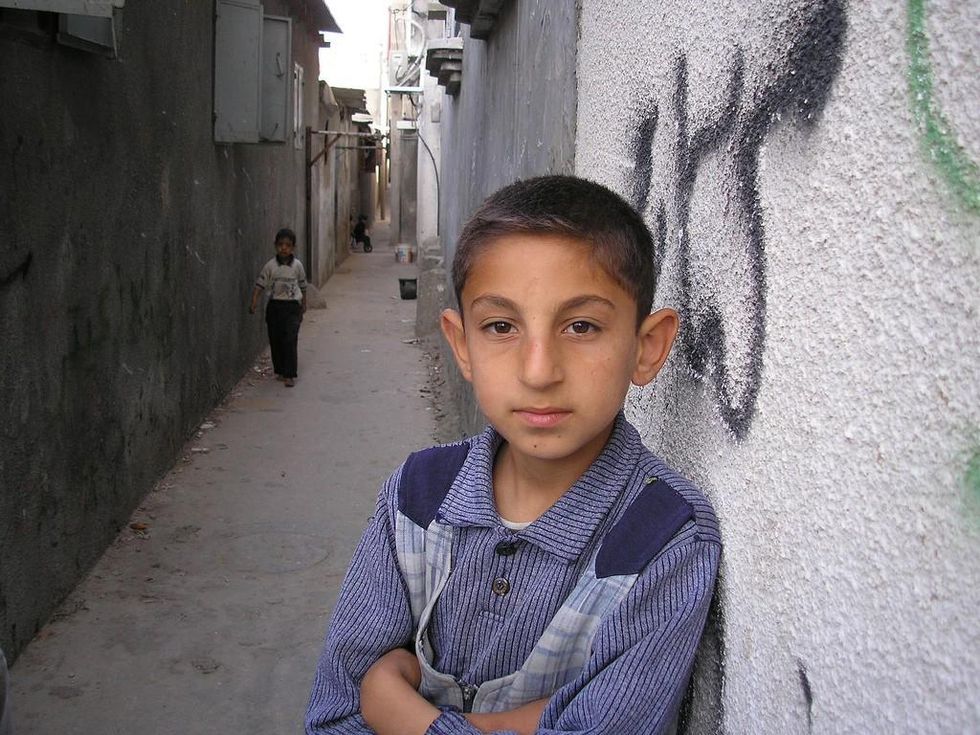A 'Child' Is Missing-From a New York Times Headline
Read this headline from the New York Times (11/16/14):
Palestinian Shot by Israeli Troops at Gaza Border
Think for a second about what kind of image that calls up. How much does that image change when you read the story's second sentence?
A spokeswoman for the hospital said the Palestinian was a 10-year-old boy.
Now, very few people read the full text of every story in any newspaper, so as an editor you have to ask yourself what a headline conveys on its own. I expect that most people who only read that headline assumed that the Palestinian referenced was an adult-and likely had a different reaction to the story as a result.
They were probably also less likely to read the story-the opposite of the effect that you usually want to have with a headline-which makes you wonder why the Times would leave this key fact out. Space, maybe? But "Gazan Boy Shot by Israeli Troops at Border" would have fit just as easily.

Or "Child Shot by Israeli Troops at Gaza Border," for that matter, since the shooting victim's likely nationality would be clear from context; there aren't too many Israeli children near the border with Gaza. In any case, the victim's age is arguably a more important fact than his ethnicity.
So-did the editors leave out of the headline the fact that it was a child who had been shot because they didn't want readers to get too upset about Israel doing the shooting?
Surely they would say no-but recall that New York Times story (7/16/14; FAIR Blog, 7/17/14), accurately headlined "Four Young Boys Killed Playing on Gaza Beach," that was rewritten for the print edition as "Boys Drawn to Gaza Beach, and Into Center of Mideast Strife." Here the boys remained boys, but their deaths disappeared.
When Times public editor Margaret Sullivan (7/22/14) asked why the headline had been changed, executive editor Dean Baquet claimed that print headlines tend to be "a little poetic." Keats it ain't.
To take a quantitative look at this phenomenon, let's move from the New York Times to an outlet that fancies itself to be the New York Times of the airwaves-NPR. FAIR's Seth Ackerman (Extra!, 11/01) did a study of which deaths it reported in the Israeli/Palestinian conflict over a six-month period. He found that NPR reported 81 percent of the Israeli deaths during that time, and 89 percent of the deaths of Israeli children-but only 34 percent of the Palestinian deaths, and 26 percent of the deaths of Palestinian children.
So while NPR-understandably-thought that being a child made an Israeli victim's death more newsworthy, if Palestinian victims were children that made NPR less likely to report their deaths.
That's an odd sort of news judgment-unless what's being aimed at is not maximizing human interest, but keeping it to a minimum.
An Urgent Message From Our Co-Founder
Dear Common Dreams reader, The U.S. is on a fast track to authoritarianism like nothing I've ever seen. Meanwhile, corporate news outlets are utterly capitulating to Trump, twisting their coverage to avoid drawing his ire while lining up to stuff cash in his pockets. That's why I believe that Common Dreams is doing the best and most consequential reporting that we've ever done. Our small but mighty team is a progressive reporting powerhouse, covering the news every day that the corporate media never will. Our mission has always been simple: To inform. To inspire. And to ignite change for the common good. Now here's the key piece that I want all our readers to understand: None of this would be possible without your financial support. That's not just some fundraising cliche. It's the absolute and literal truth. We don't accept corporate advertising and never will. We don't have a paywall because we don't think people should be blocked from critical news based on their ability to pay. Everything we do is funded by the donations of readers like you. Will you donate now to help power the nonprofit, independent reporting of Common Dreams? Thank you for being a vital member of our community. Together, we can keep independent journalism alive when it’s needed most. - Craig Brown, Co-founder |
Read this headline from the New York Times (11/16/14):
Palestinian Shot by Israeli Troops at Gaza Border
Think for a second about what kind of image that calls up. How much does that image change when you read the story's second sentence?
A spokeswoman for the hospital said the Palestinian was a 10-year-old boy.
Now, very few people read the full text of every story in any newspaper, so as an editor you have to ask yourself what a headline conveys on its own. I expect that most people who only read that headline assumed that the Palestinian referenced was an adult-and likely had a different reaction to the story as a result.
They were probably also less likely to read the story-the opposite of the effect that you usually want to have with a headline-which makes you wonder why the Times would leave this key fact out. Space, maybe? But "Gazan Boy Shot by Israeli Troops at Border" would have fit just as easily.

Or "Child Shot by Israeli Troops at Gaza Border," for that matter, since the shooting victim's likely nationality would be clear from context; there aren't too many Israeli children near the border with Gaza. In any case, the victim's age is arguably a more important fact than his ethnicity.
So-did the editors leave out of the headline the fact that it was a child who had been shot because they didn't want readers to get too upset about Israel doing the shooting?
Surely they would say no-but recall that New York Times story (7/16/14; FAIR Blog, 7/17/14), accurately headlined "Four Young Boys Killed Playing on Gaza Beach," that was rewritten for the print edition as "Boys Drawn to Gaza Beach, and Into Center of Mideast Strife." Here the boys remained boys, but their deaths disappeared.
When Times public editor Margaret Sullivan (7/22/14) asked why the headline had been changed, executive editor Dean Baquet claimed that print headlines tend to be "a little poetic." Keats it ain't.
To take a quantitative look at this phenomenon, let's move from the New York Times to an outlet that fancies itself to be the New York Times of the airwaves-NPR. FAIR's Seth Ackerman (Extra!, 11/01) did a study of which deaths it reported in the Israeli/Palestinian conflict over a six-month period. He found that NPR reported 81 percent of the Israeli deaths during that time, and 89 percent of the deaths of Israeli children-but only 34 percent of the Palestinian deaths, and 26 percent of the deaths of Palestinian children.
So while NPR-understandably-thought that being a child made an Israeli victim's death more newsworthy, if Palestinian victims were children that made NPR less likely to report their deaths.
That's an odd sort of news judgment-unless what's being aimed at is not maximizing human interest, but keeping it to a minimum.
Read this headline from the New York Times (11/16/14):
Palestinian Shot by Israeli Troops at Gaza Border
Think for a second about what kind of image that calls up. How much does that image change when you read the story's second sentence?
A spokeswoman for the hospital said the Palestinian was a 10-year-old boy.
Now, very few people read the full text of every story in any newspaper, so as an editor you have to ask yourself what a headline conveys on its own. I expect that most people who only read that headline assumed that the Palestinian referenced was an adult-and likely had a different reaction to the story as a result.
They were probably also less likely to read the story-the opposite of the effect that you usually want to have with a headline-which makes you wonder why the Times would leave this key fact out. Space, maybe? But "Gazan Boy Shot by Israeli Troops at Border" would have fit just as easily.

Or "Child Shot by Israeli Troops at Gaza Border," for that matter, since the shooting victim's likely nationality would be clear from context; there aren't too many Israeli children near the border with Gaza. In any case, the victim's age is arguably a more important fact than his ethnicity.
So-did the editors leave out of the headline the fact that it was a child who had been shot because they didn't want readers to get too upset about Israel doing the shooting?
Surely they would say no-but recall that New York Times story (7/16/14; FAIR Blog, 7/17/14), accurately headlined "Four Young Boys Killed Playing on Gaza Beach," that was rewritten for the print edition as "Boys Drawn to Gaza Beach, and Into Center of Mideast Strife." Here the boys remained boys, but their deaths disappeared.
When Times public editor Margaret Sullivan (7/22/14) asked why the headline had been changed, executive editor Dean Baquet claimed that print headlines tend to be "a little poetic." Keats it ain't.
To take a quantitative look at this phenomenon, let's move from the New York Times to an outlet that fancies itself to be the New York Times of the airwaves-NPR. FAIR's Seth Ackerman (Extra!, 11/01) did a study of which deaths it reported in the Israeli/Palestinian conflict over a six-month period. He found that NPR reported 81 percent of the Israeli deaths during that time, and 89 percent of the deaths of Israeli children-but only 34 percent of the Palestinian deaths, and 26 percent of the deaths of Palestinian children.
So while NPR-understandably-thought that being a child made an Israeli victim's death more newsworthy, if Palestinian victims were children that made NPR less likely to report their deaths.
That's an odd sort of news judgment-unless what's being aimed at is not maximizing human interest, but keeping it to a minimum.

